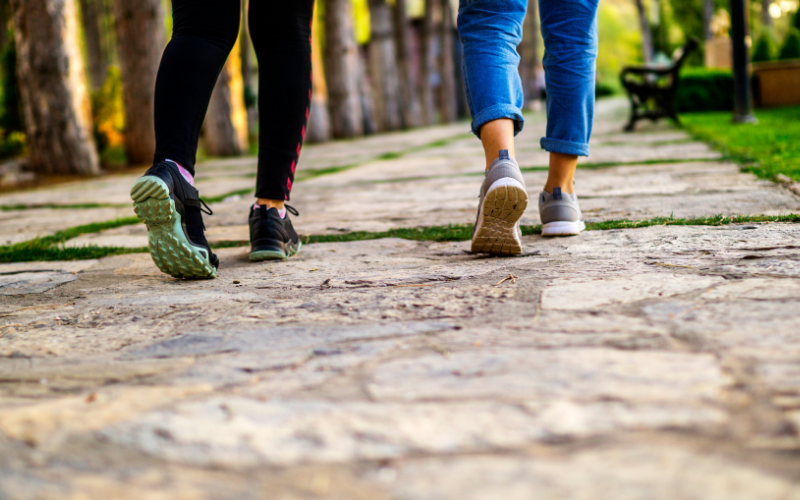Move more, feel better
Move more, feel better
Sounds obvious right? But it’s not always easy, so read my article full of helpful tips and ideas I wrote for Healthy Food Guide below.
With our busy schedules it can be difficult to find time to hit the gym or head out for a run so, unfortunately, exercise often gets put in the ‘too hard basket’.
Keeping your daily routine as active as possible can provide many positives, and this challenge is about finding ways to increase movement without it impacting your already busy schedule. Incidental exercise can help to keep you mobile, burn energy and remain fit.
Your Challenge: Commit to at least three changes that will help increase your level of activity throughout the day.
Why bother? There are so many benefits to being more active:
Helping you to feel less tired and boost your energy
Great for stress-busting
Keeping your bones and muscles strong and joints flexible
Possible financial benefits! If you bike or eBike to work you can save money! Replace 100km a week in a car for a cycling/eBiking and it will save you over $940 a year*
By moving more and using motor vehicles less, you’ll also have a positive impact on the environment.
Managing your waistline. Just 15 minutes of brisk walking or stair climbing a day can burn off roughly 120kcals, the same as 1.5 slices of bread, a small glass or wine or a beer**
Reducing risk of heart disease, type 2 diabetes, high blood pressure and high cholesterol
How to make it happen!
Incidental activity is any activity built up in small amounts over the day. For example, walking up the stairs or to the bus stop.
Even just standing up helps. You could choose to stand on the bus or train to work, or stand up from your desk and stretch, or stand whenever talking on the phone.
Below are some helpful ways to increase your incidental activity that won’t dramatically impact your normal routine. Because, ultimately, any exercise is better than nothing!
At work:
Walk up stairs instead of taking the lift
Cycle or walk to work, instead of driving
Get off the train or bus a few stops earlier or park further away and walking
Organise a regular exercise session at work and encourage everyone to get involved
Leave the office during your lunch break and go for a 10-15 minute walk
Walk around the office during calls (if you are not required to be seated at your desk)
Try the new coffee place a few blocks over, instead of the one in your building
Walk to talk to colleagues instead of sending an email
Take comfortable walking shoes to work – this gives you one less excuse not to exercise
Use a fitness tracker – most phones these days have one that will track the number of steps you do per day. Try to beat your daily target and increase your goal over time
Take ‘active breaks’ throughout the day, eg doing some desk exercises, taking the long way to the toilets
See if there is an option to get a stand-up desk
At home:
Go for a short walk before breakfast or after dinner
Be active while watching TV, eg riding an exercise bike or walking on a treadmill
Perform squats or calf raises while waiting for the kettle to boil or for the microwave timer to count down
If you don’t have a dog, take someone else’s for a walk
‘Active ads’ – during TV commercials do something active, eg squat, walk or try some core exercises
Challenge yourself to do the washing, vacuuming or mopping a bit quicker, to work up a sweat
Take smaller loads of washing up/down the stairs (or from room to room) rather than doing it in one large go
Do the housework instead of hiring someone to help
Do some gardening or mow the lawn
Break up long periods of sitting
Stand up to stretch often – for at least a few minutes each hour
Stand while you are travelling on buses, trains and ferries
Get off the bus or train one stop earlier and walk the rest of the way, or park further away
Limit TV, computer and other electronic device use when you are at home. Go for a walk instead. Stand up and stretch when the ads come on TV
Stand up while texting or talking on the phone.
Leisure time:
As well as the things you can do every day, try to make your leisure time more active too
Park further away from the shopping centre and walk the extra distance
While at the shops add in an extra lap of the centre
If you have kids who are playing, get involved rather than watching
Make your leisure activities more active:
Walk at golf instead of using the buggy
Walk along the beach
Kick or throw a ball at the park
Organise active family outings
Go for a bushwalk
Hire push-bikes for the afternoon
Head down to the local pool for a swim
Keep a soccer ball, skipping rope or frisbee in the car
Walk around the field while you’re watching your kids’ Saturday sport
Walk to your local restaurant/shops/café, instead of driving
Meet friends for a takeaway coffee then catch up and chat while walking
Take action
Now is your time to select and WRITE down which of these three things (minimum) you are going to commit to. Add reminders to your calendar or planner to help make it more likely for these changes to happen. Also, you can buddy up with someone else in your workplace and commit to the same three changes together and keep each other accountable.
*Based on IRD rate per kilometre for 100kms.
**The number of calories burned will depend on many factors including how fast you are going and how much you weigh.
Healthy Food Guide Article here


